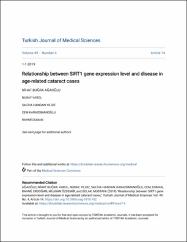Relationship between SIRT1 gene expression level and disease in age-related cataract cases

Göster/
Erişim
info:eu-repo/semantics/openAccessTarih
2019Yazar
Ağaoğlu, Nihat BuğraVarol, Nuray
Yıldız, Saliha Handan
Karaosmanoğlu, Cem
Duman, Rahmi
Özdemir Erdoğan, Müjgan
Solak, Mustafa
Üst veri
Tüm öğe kaydını gösterÖzet
Background/aim: Age-related cataract is the most important visual impairment all over the world. Epigenetic modifications, especially overexpression of histone deacetylases, have become the focus of interest for cataract development in recent years. Sirtuin 1 (SIRT1), a class II histone deacetylase and a member of the sirtuin family, is one of the best-characterized histone deacetylases and has a pivotal role in age-related diseases. However, the association of SIRT1 with age-related cataracts has not yet been fully elucidated. Therefore, we aimed to determine the expression of SIRT1 in age-related cataract patients. Materials and methods: Expressions of SIRT1 were evaluated by quantitative polymerase chain reaction (qPCR) in patients and healthy controls. RNA samples were collected from the anterior capsule and peripheral blood samples of age-related cataract patients. Human lens epithelial cell line B3 and peripheral blood samples of healthy subjects were used as controls. Results: We determined that the expression of SIRT1 in blood and anterior capsule samples increased significantly compared to the control group (P < 0.05). Conclusion: The expression level of SIRT1 plays a vital role in the development of age-related cataract and it can be used as a biomarker. Thus, SIRT1 inhibitors can be used in the treatment of age-related cataract disease.
Kaynak
Turkish Journal of Medical SciencesCilt
49Sayı
4Bağlantı
https://doi.org/10.3906/sag-1810-182https://app.trdizin.gov.tr/makale/TXpNMk5ESXlNZz09
https://hdl.handle.net/20.500.12933/523















